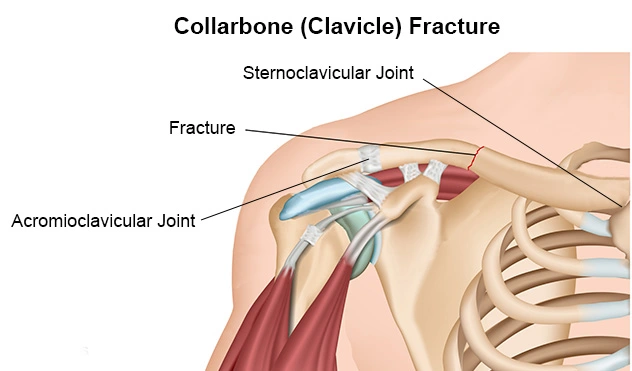
Clavicle Fracture treatment surgery cost Indore
A clavicle fracture is a break in the collarbone, one of the main bones in the shoulder. This type of fracture is fairly common—accounting for about 5 percent of all adult fractures. Most clavicle fractures occur when a fall onto the shoulder or an outstretched arm puts enough pressure on the bone that it snaps or breaks. A broken collarbone can be very painful and can make it hard to move your arm.
Most clavicle fractures can be treated by wearing a sling to keep the arm and shoulder from moving while the bone heals. With some clavicle fractures, however, the pieces of bone move far out of place when the injury occurs. For these more complicated fractures, surgery may be needed to realign the collarbone.
The clavicle is the bone that connects the breastplate (sternum) to the shoulder. It is a very solid bone that has a slight S-shape and can be easily seen in many people. It connects to the sternum at a joint with cartilage called the sternoclavicular joint. At the other end, the bone meets the shoulder area at a part of the shoulder blade (scapula) called the acromion. The joint at that end of the bone containing cartilage is called the acromioclavicular joint.
When bones break, there is swelling due to bleeding from the blood vessels in and around the bone. There is also pain from the broken bone due to damage of microscopic nerve endings around the bone. Sometimes the bone is broken enough to create an angle between the broken ends, which causes a deformity along the bone. Usually with a broken collarbone the pain and swelling are severe and there may be a visible deformity. Often there is pain at the site of the fracture with any attempt to move the arm. The only way to verify if there is a fracture is to get an X-ray of the area.
If you think that the clavicle is broken, it is best to seek medical treatment right away. The best way to treat the injury until you can reach a physician or emergency facility is to immobilize the arm and shoulder by holding the arm close to the body with the other arm or in a sling. You should put ice on the injured area for 20 to 30 minutes at a time, making sure not to freeze the skin. Pain medication such as Tylenol or over-the-counter nonsteroidal agents such as ibuprofen or naproxen (Advil or Aleve, for example) are acceptable. The only time you should not take medication is if there is a break in the skin over the fracture, which indicates that the ends of the bones may have punctured the skin. In that case, the fracture may need surgery to clean out any dirt or debris. Other indications of more severe injury include tingling, numbness or weakness in the hand or arm. If the injury is near the sternum and you have shortness of breath or difficulty swallowing you should seek immediate medical attention.
If you are experiencing joint problems due to injury, arthritis, or other causes, gives us a call.

